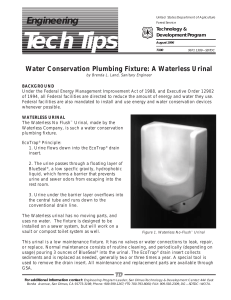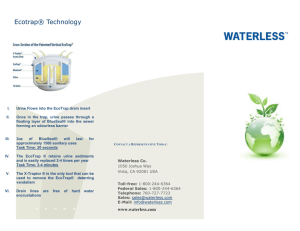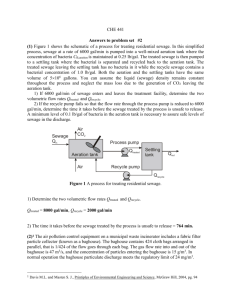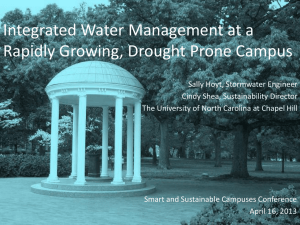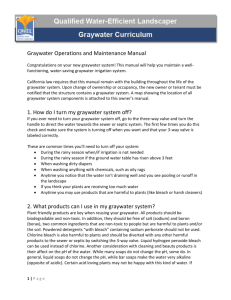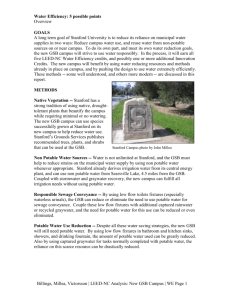WE Credit 2: Innovative Wastewater Technologies
advertisement
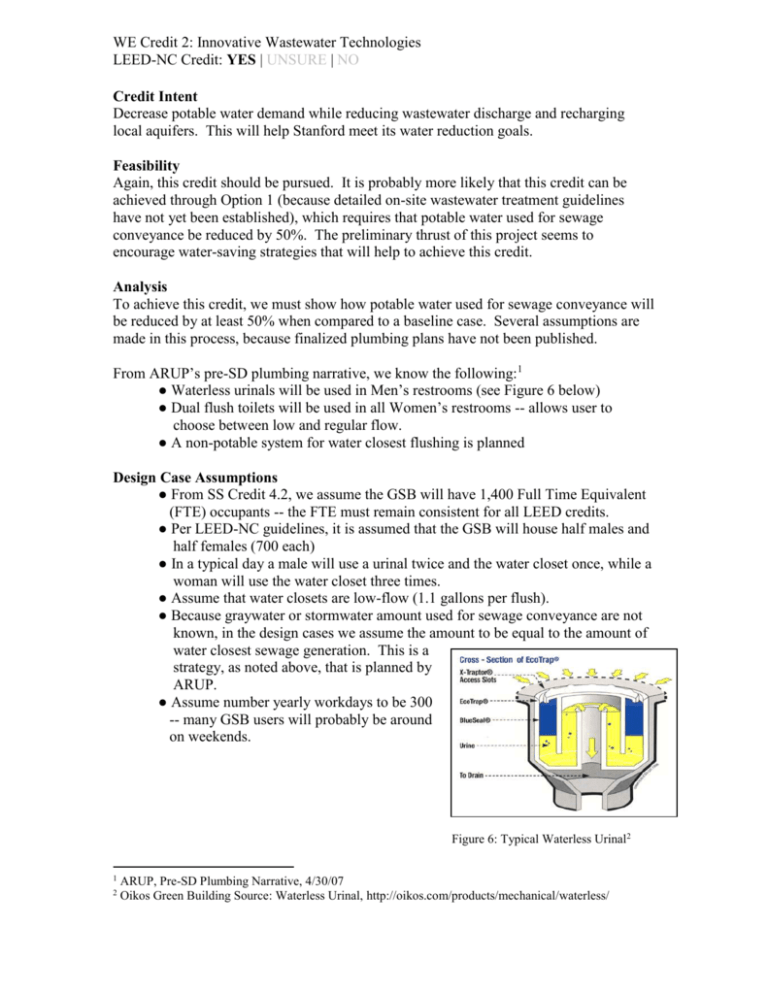
WE Credit 2: Innovative Wastewater Technologies LEED-NC Credit: YES | UNSURE | NO Credit Intent Decrease potable water demand while reducing wastewater discharge and recharging local aquifers. This will help Stanford meet its water reduction goals. Feasibility Again, this credit should be pursued. It is probably more likely that this credit can be achieved through Option 1 (because detailed on-site wastewater treatment guidelines have not yet been established), which requires that potable water used for sewage conveyance be reduced by 50%. The preliminary thrust of this project seems to encourage water-saving strategies that will help to achieve this credit. Analysis To achieve this credit, we must show how potable water used for sewage conveyance will be reduced by at least 50% when compared to a baseline case. Several assumptions are made in this process, because finalized plumbing plans have not been published. From ARUP’s pre-SD plumbing narrative, we know the following:1 ● Waterless urinals will be used in Men’s restrooms (see Figure 6 below) ● Dual flush toilets will be used in all Women’s restrooms -- allows user to choose between low and regular flow. ● A non-potable system for water closest flushing is planned Design Case Assumptions ● From SS Credit 4.2, we assume the GSB will have 1,400 Full Time Equivalent (FTE) occupants -- the FTE must remain consistent for all LEED credits. ● Per LEED-NC guidelines, it is assumed that the GSB will house half males and half females (700 each) ● In a typical day a male will use a urinal twice and the water closet once, while a woman will use the water closet three times. ● Assume that water closets are low-flow (1.1 gallons per flush). ● Because graywater or stormwater amount used for sewage conveyance are not known, in the design cases we assume the amount to be equal to the amount of water closest sewage generation. This is a strategy, as noted above, that is planned by ARUP. ● Assume number yearly workdays to be 300 -- many GSB users will probably be around on weekends. Figure 6: Typical Waterless Urinal2 1 2 ARUP, Pre-SD Plumbing Narrative, 4/30/07 Oikos Green Building Source: Waterless Urinal, http://oikos.com/products/mechanical/waterless/ WE Credit 2: Innovative Wastewater Technologies LEED-NC Credit: YES | UNSURE | NO Design Case Fixture Type Daily Uses Waterless Urinal (Male) Waterless Urinal (Female) Watercloset (Male) Watercloset (Female) Flowrate, gpf 2 0 1 3 Occupants 0 0 1.1 1.1 Sewage Generation, gal 700 700 700 700 0 0 770 2310 Totally Daily Volume, gal Annual Work Days Annual Volume, gal Rain/Graywater volume, gal 3080 300 924000 924000 TOTAL ANNUAL VOLUME 0 Baseline Case Assumptions Same number of daily uses and occupants as design case assumed. Flow rates of water closets increased to 1.6 gallons per flush, and urinal flow rates increased to 1.0 gallons per flush. We also assume that no rain or graywater is used for sewage conveyance. Baseline Case Fixture Type Daily Uses Conventional Urinal (Male) Conventional Urinal (Female) Watercloset (Male) Watercloset (Female) Flowrate, gpf 2 0 1 3 700 700 700 700 Sewage Generation, gal 1400 0 1120 3360 Totally Daily Volume, gal Annual Work Days Annual Volume, gal Rain/Graywater volume, gal 5880 300 1764000 0 TOTAL ANNUAL VOLUME 1764000 1 1 1.6 1.6 Occupants So we see that we definitely have reduced potable water used for sewage conveyance, in this case by using no potable water at all. It should be noted that if the calculations for the design case hold in the actual GSB (i.e., all waterless urinals, and no potable water used in water closets), then an Innovation Credit would be earned. Also, if we disregard the planned use rainwater or graywater for sewage conveyance, we still achieve a 47% decrease in potable water use. With some additional adjustments (i.e., using even a minimal amount -- 28,000 gallons -- of graywater) this credit could still be achieved. [(1-(924000/1764000))*100 = 47.6%]
